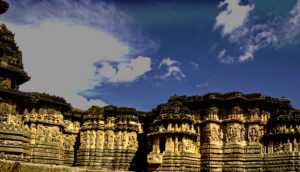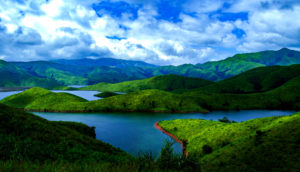Beluru (also known earlier as Velapuri, Velur and Belapur in olden times) is situated on the banks of Yagachi River and was one of the capitals of the Hoysala Empire. Renowned for its magnificent Hoysala temple complex, the Chennakeshava Temple (also called Vijaya Narayana Temple), which was built by Hoysala King Vishnuvardhana to commemorate his victory over the Cholas in 1116 AD. The temple is believed to have been built by master craftsmen – Dasoja and Chavana, a father and son duo.
Beluru Chennakeshava Temple:
This star shaped temple is believed to have taken around 103 years to build. At the entrance facing the temple is a towering Gopura and a magnificent sculpture of Garuda, Lord Vishnu’s carrier, palms touching in pious homage. The temple stands on a platform and has exquisite artwork on its outer walls adorned with bracket figures depicting the Puranas and Epics, all carved to perfection. The lower frieze has a series of charging elephants and horses; the elephants symbolize courage while the horses are for speed. It is also believed that Shantaladevi, the queen of King Vishnuvardhana is the model for one of the sculptures – Darpana Sundari (lady with the mirror). Just outside is an interesting piece of sculpture, called the Gravity pillar which is carved out of a single rock and stands in its own weight. People can actually swipe a piece of paper across it. Equally impressive are the temples of Kappe Chennigaraya, Soumyanayaki, Andal and other Vaishnava manifestations, which surround the main temple.
And if you thought that, this is supreme stone carving skills, then just step inside. The craftmanship inside is much finer than outside. The sanctum has a magnificent 3.7 m tall image of Lord Vijaya Narayana in black stone. The prabhavali of this idol has the 10 avatars of Lord Vishnu, wrought very perfectly. The doorway with the dwarapalakas is very elegantly carved. The Garbhagriha is stellar in shape and its zigzag walls make the figures of 24 forms of Lord Vishnu look different at different times of the day due to light and shade effect.
The bracket figures of madanikas (celestial nymps) are elaborately done with even water drops chiseled to perfection. There are 4 bracket figures on the ceiling which is believed to be inspired by queen Shantaladevi’s beauty. One can see the lathe turned pillars highly polished and intricate carvings even in the dark and no two pillars are alike. The Narasimha Pillar, it seems, was built to rotate on its base. The Mohini Pillar is the most beautiful among the pillars. A unique aspect in this is the artist has left a small space blank – it is believed that it is a challenge to others to do a better carving and to convey that art never dies as it is infinite.
Chennakeshava Temple is proposed to be listed under UNESCO World Heritage Sites.
It is open daily from 7.30 AM till 7.30 PM.
Nearby: Halebeedu (20 kms), Mullayyanagiri Peak (50 kms), Shettihalli Church (55 kms), Yagachi Dam (4 kms) and Sakaleshpura (35 kms) are some attractions that can be visited along with Beluru.
Visit: Beluru is 220 kms from Bengaluru and 155 kms from Mangaluru. Mangaluru is also the nearest airport. Hasana junction 40 kms away is the nearest railway station. Bus services are available to reach Beluru from Hasana city. Beluru and surrounding areas are best explored in a taxi/own vehicle.
Stay: KSTDC runs the hotel Mayura Velapuri, 500 meters from Beluru Chennakeshava Temple complex. Hasana city, 40 kms from Beluru has more stay options.





